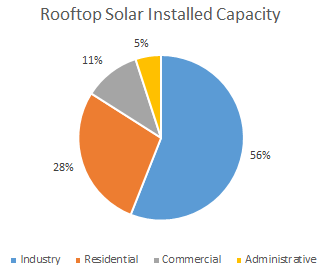Looking at rooftop solar trends in Vietnam
/A few articles have come out over the past few days looking at the solar/renewables market in Vietnam.
Source: PV Magazine
There was some interesting data in this article, in particular. I didn’t realize that there have been “27,845 systems with 573MW installed capacity” added to the market in the past nine months.
Note that rooftop solar is defined as:
“[A] solar power system with photovoltaic panels installed on the roofs of civil works or industrial works and has a capacity of less than or equal to 1MWp and directly or indirectly connected to the electricity purchaser with the line of 35kV or less.
So that could limit some larger industrial installations.
In spite of that (probably 1MWp is plenty big), most of it is installations are industrial. They see have the most to gain in absolute terms, plus they are used to making a decision based on cash flows over a long-term horizon. Residential is also quite high at 28%. Commercial (retail, shops, restaurants) may be a harder sell, because who pays for it? Is it the landlord or the tenant? And who gets the rewards?
According to this data, almost all the installations have been in the south, which is not really a surprise. We have talked about the new FiTs earlier (here). For every province but Ninh Thuan, they expire this year (next for Ninh Thuan), and then it looks like it goes to auctions (unless something has changed). That’s might be a good alternative, because it could allow more capacity to be installed in the north. Right now, it is better and more lucrative to install capacity in the south, because there is more sun. Without different prices for different areas, it makes sense to always go where the sun is brighter.
Separately, China, which has tried to be a leader on policy to address climate change (although is also a large and rising contributor to it), may be backsliding. But “as the economic pressure from Covid-19 increased, China began to loosen restrictions on industrial pollution and is inching back toward coal as a cheap source of power.” COVID actually helped reduce pollution globally, but let’s see what happens when the economy comes back.
Source: PV Magazine
Source: PV Magazine




